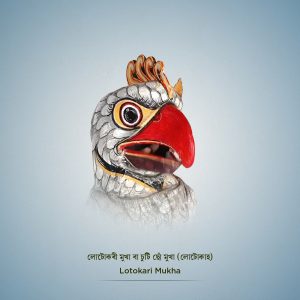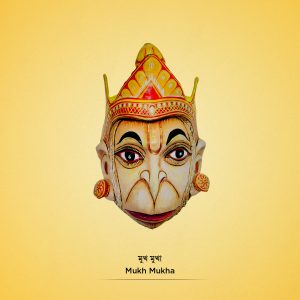Mask Making Tradition of Assam
 The neo-Vaishnavism propagated by Mahapurush Srimanta Sankardev and the wonderful creations of Gurujana such dance and music, bhaona (a type of drama), etc., showed the path of harmony to the Assamese society. His discourses helped various diverse ethnic groups amalgamate in the greater Assamese society. The art of mask making is Gurujana’s one of the most unique creations that became a traditional folk art of Assam. Masks first became a part of bhaona performances in the 15th century.
The neo-Vaishnavism propagated by Mahapurush Srimanta Sankardev and the wonderful creations of Gurujana such dance and music, bhaona (a type of drama), etc., showed the path of harmony to the Assamese society. His discourses helped various diverse ethnic groups amalgamate in the greater Assamese society. The art of mask making is Gurujana’s one of the most unique creations that became a traditional folk art of Assam. Masks first became a part of bhaona performances in the 15th century.
Sri Sri Samaguri Satra of Majuli is a major centre of attraction for tourists for its unique mask making tradition. For centuries, the art of mask making has been prevalent in this Satra. Many people from different parts of the state as well as from home and abroad go there to learn the art.
Types of Masks:
Traditionally, masks are divided into three types.
- Barmukha or Great Mask

These masks are made in two parts – part of the torso and part of the head. The performer wears both torso and head parts during the act. This mask is at least 10-12 feet high and hence called Barmukha.
- Lotokari Mukha or Hanging Mask

These masks are smaller than Barmukha, but the torso and head parts are made in the same way as Barmukhas. The only difference is that the head mask is flexible, making it easier for the artiste to move his head and body. Examples: Putana, Taraka, Maricha, Subahu, etc.
- Mukh Mukha or Face Mask

This mask covers only the performer’s face while the rest of the body is decorated with attractive costumes that match the mask. Since they supplement the dress, these masks are also said to be ornamental.
Tools of Mask Making:
The tools used for making masks are produced locally, such as bamboo, cane, cotton cloth, cow dung, clay, cork, jute, et cetera. Mask makers traditionally use natural colours and dyes, such as tree seeds, bark, leaves, bael sap, wheat plant sap, and other traditionally-used minerals such as vermilion, yellow orpiment, mustard-oil lamp ash, and indigo.
Method of Mask Making:
A 3-year-old jati bamboo is cut into 3-4 feet wickers to make masks. The mask is prepared as per the face measurements. Then the bamboo is covered with clay-coated cotton cloth. It is dried in the sun and then shaped and sculpted according to character with cow dung and clay mixed in a 3:1 ratio. It is left to dry further in the sun. Then a small mixture of clay and cow dung is plastered on it for smoothening the surface. After drying completely, it is painted after which the mask is ready.
All the three types of masks used in bhaona are made using the same method.
Use of Masks:
‘Cihna Yatra’, the first play composed by Gurajana was the first to feature masks for characters which otherwise cannot be showcased by human face, such as Garuda, four-headed Brahma, Lord Shiva, etc. The ‘Ramayana’ has many such characters like Ravana, Kumbhakarna, Surpanakha, Jatayu, Taraka, Maricha, Subahu, Sugriva, etc. Similarly, the ten incarnations of Lord Vishnu including Matsya, Kurma and Narasimha are also shown using masks. The mask exhibition at the Raas Mahotsav is quite a spectacle. Gurujana Srimanta Sankardev’s successors have also written many plays based on ‘Ramayana’, ‘Mahabharata’ and ‘Puranas’ and enriched coffers of Sattriya culture.
Apart from being traditionally used in Sattriya Bhaona, the masks are also used in other dramas and plays called Mukha Bhaona. In the present time, this art form has achieved worldwide recognition and global attraction due to the complex movement of organs such as eyes, mouth and waving.
At present, masks are not only used in bhaona but also for other purposes such as gift, festivals, meetings, house decorations, etc. This commercialisation has financially empowered the mask artists, and attracted enthusiastic learners especially the young generation. Traditional masks of Assam have also been also exhibited abroad including British Museum in London besides schools, university archives and airports.
Data Collection: Sri Hemchandra Goswami
Eminent Mask Artist
Sri Sri Samaguri Satra


